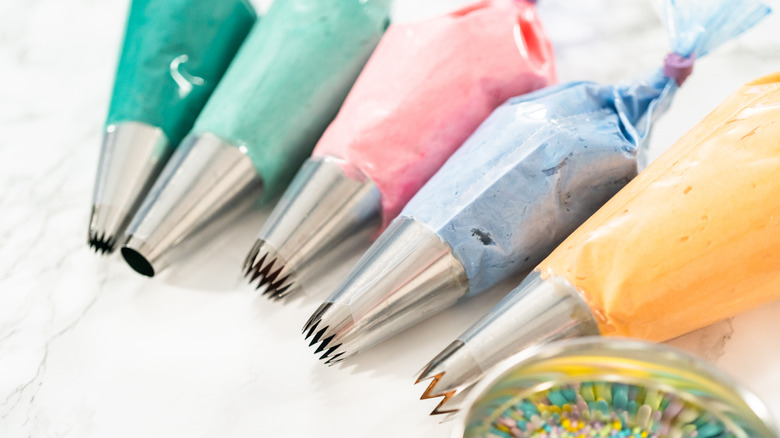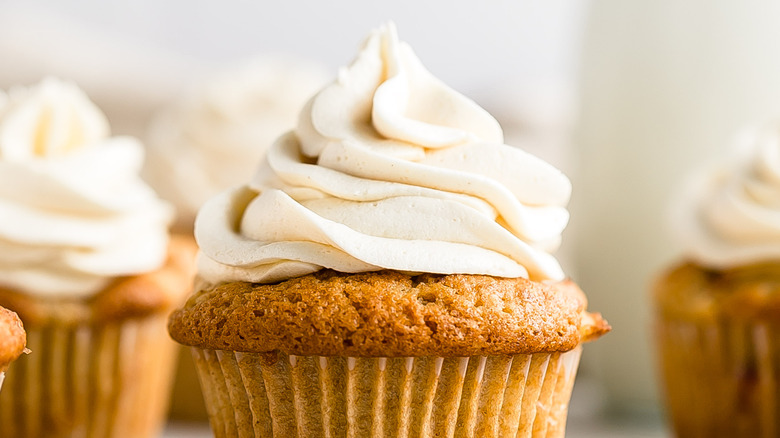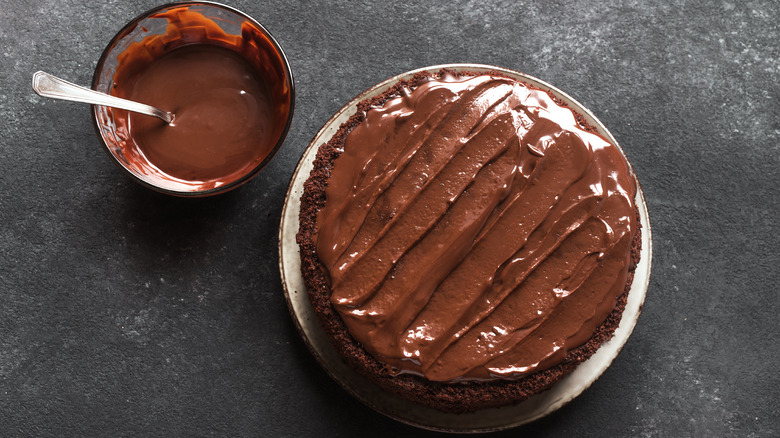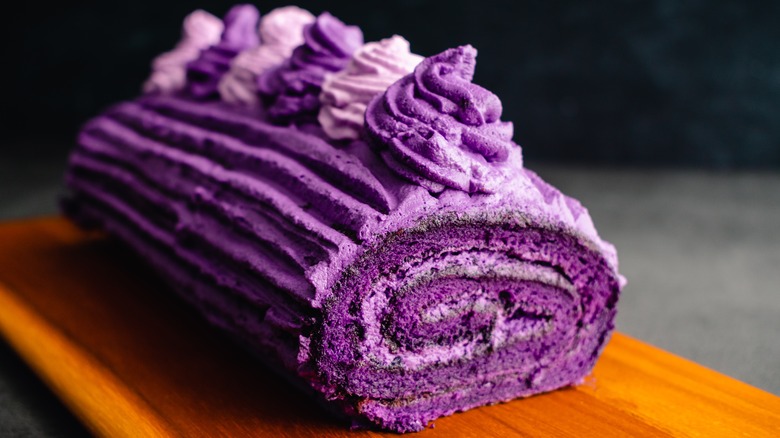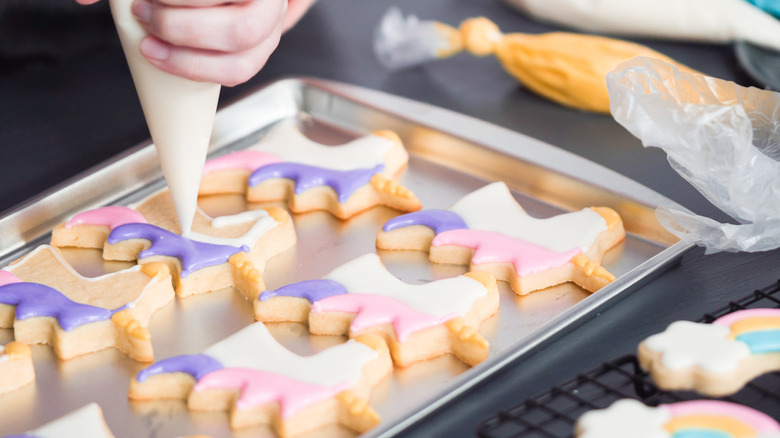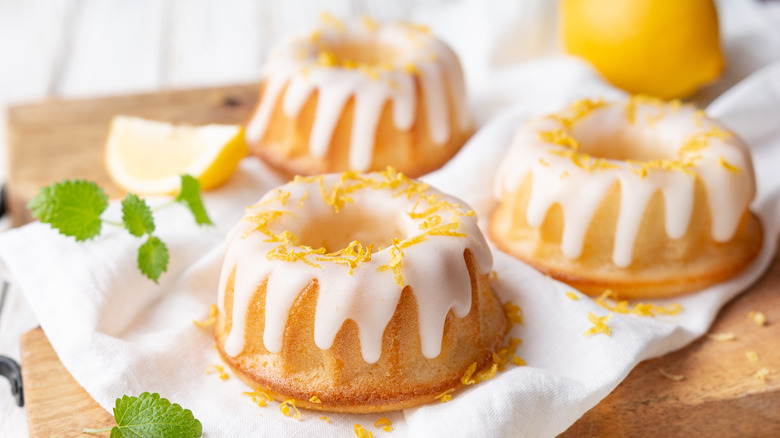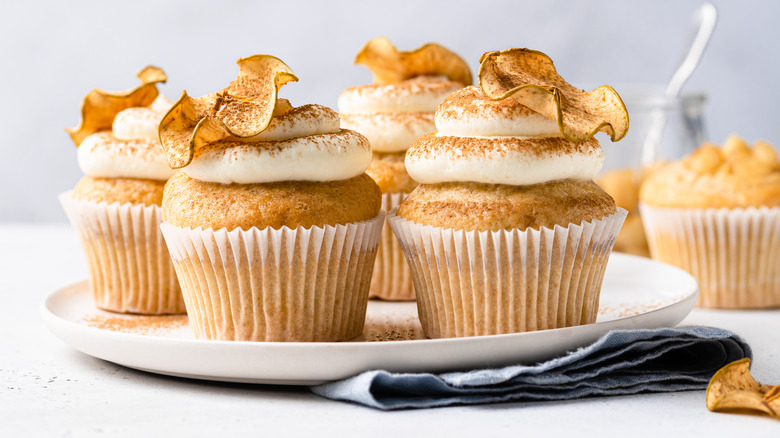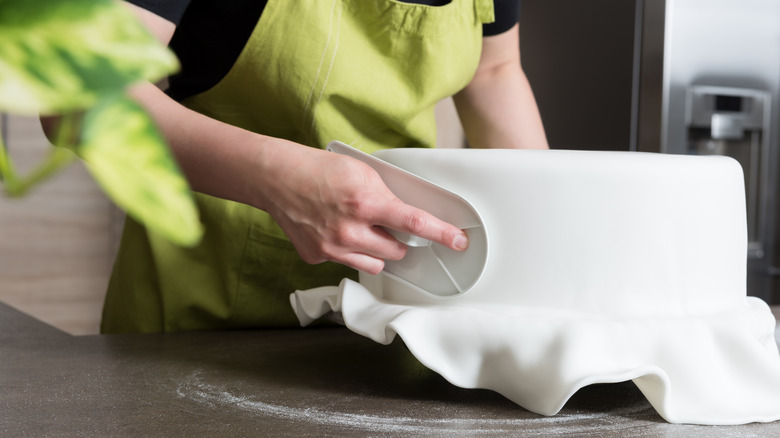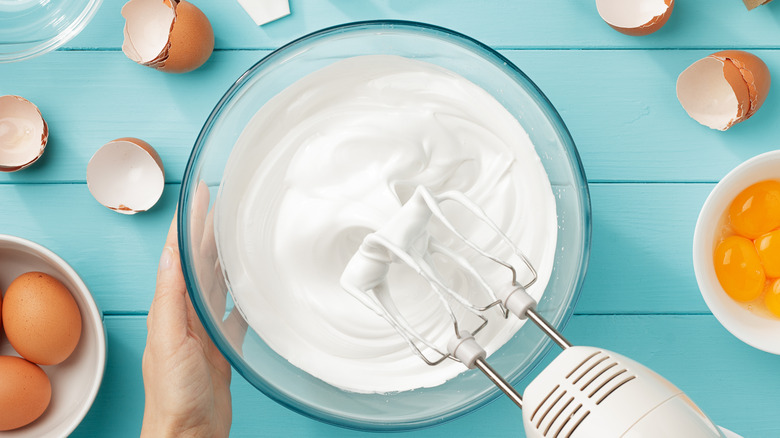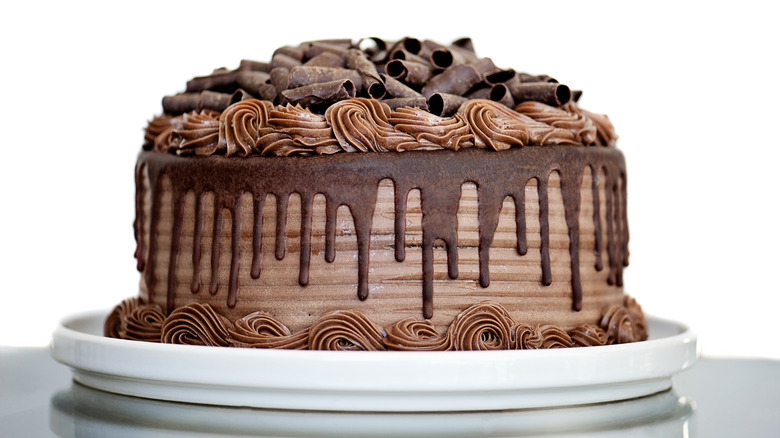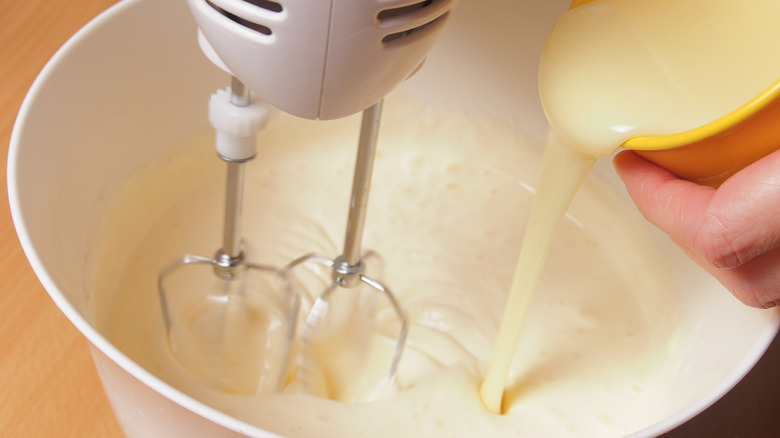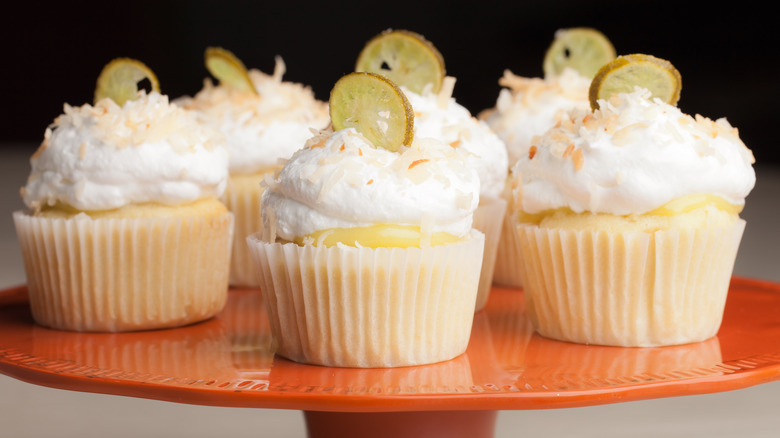11 Types Of Frosting And How To Use Them
What do cakes, cookies, pastries, donuts, and cupcakes all have in common? Well, aside from their finger-licking goodness, they are all begging to be decorated, draped, or drizzled with some sort of frosting. This finishing step is arguably the most crucial element of so many baked goods. Adding sweet, sticky frosting can practically transform your desserts from just fine to a slice of heaven.
But not all frosting is created equal, and knowing which type to use to top your desserts is key. If you thought that classic buttercream and cream cheese is all there is to frosting, then you're in for a treat. When it comes to homemade frostings, the choices are surprisingly vast and confusing at times. From light and airy whipped cream frosting to rich and chocolaty ganache, there are many options to choose from, and different desserts are suited to each unique type.
Whether you're looking to enhance the appearance of your cookies, elevate the flavor of a cake, or simply want to lick it straight off a spoon, frosting is your friend — if you know how to work with it. To help you master the basics, Mashed broke down 11 different types of frosting and exactly how to use them to make your desserts that much more delectable every time.
Classic buttercream
Even if you're not much of a sweet tooth, there is a good chance you have indulged in buttercream frosting. Classic American buttercream is a hugely popular and super versatile frosting. It can be used to decorate pretty much any dessert, from cakes and cupcakes to brownies and cookies. It's also incredibly simple to make. As BAKERpedia notes, you can make a classic American buttercream frosting with just two ingredients: creamed butter and confectioners' sugar.
Mashed's recipe for this easy, scrumptious frosting calls for 1 cup of butter along with 4 cups of powdered sugar. After creaming the butter and blending in the sugar using a stand mixer or electric beaters, you can elevate the flavor and texture by adding a splash of vanilla extract, a pinch of salt, and a little bit of whole milk to help achieve your desired frosting consistency. Bakers on Reddit also share a few tips to prevent clumping and achieve perfect buttercream every time, including using organic powdered sugar made with tapioca starch and always sifting in the sugar.
Besides being absolutely delicious, buttercream frosting is incredibly adaptable as well. The flavor options are literally endless; you can add chocolate, vanilla, berries, citrus juice, nuts, and pretty much anything else your heart desires.
Chocolate ganache
Mix cream and chocolate together, and you've got the base for another finger-licking frosting, the ganache. As one baker puts it, ganache basically tastes like chocolate truffles in frosting form (via Julia's Cake & Eat It!). Ganache can be made with milk, white, or dark chocolate and is popularly used as a glaze or for layering cakes as well as drizzling all over the top. And that's not all — ganache is also an excellent base for fondant cakes because its surface becomes hard and smooth as it sets (via Cake Central).
The experts at Fine Cooking explain how ganache is actually more versatile than you might think. It is basically a fat-in-water emulsion of chocolate and heavy cream. The ratio of those two ingredients can be altered to yield ganache of varying consistencies — from thin and saucy, to stiff and fudge-like, to light and fluffy — making it ideal for various mouth-watering treats.
However, making ganache can be a tricky business. To make sure you end up with velvety chocolate goodness instead of a burnt, clumpy mess, start by chopping up your chocolate of choice and melting it in warm cream. Then whisk to emulsify the mix until it is super smooth and flows off your spatula. Next, be sure to let it slowly cool and set before frosting your dessert. The key here is to gradually change the temperature of the chocolate, as dramatic changes can ruin the texture of your ganache (via Fine Cooking).
Whipped cream frosting
Who doesn't love whipped cream, especially when it is freshly homemade? This popular dessert topping has a light, airy texture and offers a fresh, creamy taste to your cakes and cupcakes when used as a frosting.
Basic whipped cream frosting is made from a combination of heavy cream and sugar, which are beaten together at a high speed until soft, fluffy peaks form (via Food.com). However, this cloud-like concoction may not work for much more than a few accentuating details on your dessert without one important extra ingredient. As Cake Decorist notes, egg whites or meringue powder are typically added to whipped cream frosting to act as a stabilizer, which can help prevent the frosting from deflating too quickly once it is spread on a dessert — and exposed to the elements. Furthermore, you can also add gelatin to whipped cream frosting to make it even sturdier and ready to handle some heavy-duty cake decorating.
Royal icing
Finger-licking, lip-smacking, and delightful, royal icing is the ultimate cookie frosting. It dates back to the 1600s, but really gained popularity (and its regal name) after it was used for Queen Victoria's wedding cake in 1840 (via Donna Jane Cakes).
Royal icing is basically standard icing but with a minor twist. It starts with confectioners' sugar and water, along with meringue powder or egg whites. As Food Crumbles notes, this added ingredient makes the icing quicker to set, harder, and less prone to cracking. Royal icing is arguably the best part about sugar cookies (and gingerbread, too!), but is also often used to decorate cakes. And you can definitely get creative with it, using food dye to add colorful playfulness to your baked goods, or flavor enhancers like vanilla extract and citrus juice.
Tasting Table offers up a simple royal icing recipe. It calls for 4 cups of powdered sugar, 2 large egg whites, a teaspoon of fresh lemon juice, and a teaspoon of water. Add it all to a bowl and use an electric mixer on low speed to blend until the icing is smooth. You can continue to add water, a little at a time, until you reach the consistency you're looking for — ideally, you want to see it make a ribbon trail as it falls off the spatula. And if your icing gets too thin, balance it out by adding some more powdered sugar. It's a truly foolproof frosting.
Glaze
Glaze, ganache, buttercream ... you name it, we all like to lick 'em clean from our fingers. And glaze is perhaps the easiest to whip up of all the frostings. It is made from a combination of sugar and some liquid, usually milk or water. You only need to follow three simple steps to make a powdered sugar glaze: Sift sugar, add liquid, and whisk away (via CakeWhiz). Yes, that's how easy it is. From there, you can drizzle, dip, and dunk pretty much any and every baked good with glaze, including cakes, cookies, doughnuts, and pastries.
Ending with a glossy, mirror-like finish, glazes can be made to vary both in flavor and consistency. You can control just how thin and smooth your glaze is depending on how much liquid you use. According to one baker on Reddit, you can tell your glaze is perfect when it's so shiny you can see your reflection in it. You can also change up the flavor of your glaze in various ways, adding anything from lemon juice, to spices like cinnamon or cardamom, flavor extracts, matcha, and even espresso for a delicious enhancement of your pastry items.
Cream cheese frosting
Cinnamon rolls, carrot cakes, and red velvet all share one important thing in common. Aside from being delicious, they are usually finished off with scrumptious cream cheese frosting that can make your mouth water just looking at it. Cream cheese frosting is a yummy yet simple combination of cream cheese, butter, sugar, and often vanilla extract (via Food Network). While texturally, a frosting made with cream cheese might look and feel pretty similar to buttercream, it has a more rich and complex flavor — a little tinge of tang that balances the sweetness of sugar, giving your taste buds a treat to savor in every bite.
For a quick and easy recipe for cream cheese frosting, Tasting Table says to mix 1 3/4 cups each of butter and cream cheese. After creaming those together, add 1/2 teaspoon of vanilla extract and gently mix in 1 cup of confectioners' sugar.
Fondant
Fondants can be finicky, but they are a great medium to work with. Once you get the hang of it, your creative side can do wonders with fondant, transforming a boring cake into something magical.
Fondant is a type of hard icing that comes in three forms: poured, powdered, or rolled (via Bakerpedia). Poured fondants have a paste-like texture and are typically used to make éclairs and petit fours. Powdered fondant is commercially available in the form of icing sugar. And the most common of the three, rolled fondant, has clay or dough-like texture and consistency, and is usually used for cake and cupcake decoration — either draped over as an outer covering, or molded into three-dimensional shapes and figures. This type of fondant is made of sugar, water, corn syrup, and sometimes gelatin (via Bob's Red Mill). It can also be made with powdered sugar and melted marshmallows. And while you can certainly try your hand at making it at home, you can also buy premade sheets of fondant that you can simply roll out and start using right away.
Once you achieve the right consistency, fondant is super pliable and fun to work with to bring your dessert dreams to life. The pastry experts at Wilton offer an excellent hack for working with fondant: Since fondant can dry out pretty quickly, they recommend adding some shortening to it to lock in moisture, giving you more time to practice your pastry art.
Meringue
Another more unique frosting option is the ever-classy meringue. There are three different variations: Swiss, Italian, and French. All three are made with egg whites and sugar, but they vary slightly in their preparation methods, as explained by Cooks Illustrated.. However, unless you're using a stand mixer, all three are going to require some serious strength and willpower to whip them to perfection.
French meringue is probably the simplest to make of the three. Egg whites are whipped until they are light and airy, and then sugar is slowly added. The mixture is beaten until stiff peaks form. Italian meringue takes a little more effort. It's made by whipping egg whites until stiff, and then continuing to beat them while pouring in hot sugar syrup, until the mixture forms a fluffy yet smooth and satiny texture. Swiss meringue also involves some heat in the form of a double boiler. Both egg whites and sugar are gently whisked while sitting atop boiling water and then aggressively beaten again after being pulled off the heat until the mixture forms a voluminous meringue texture.
It's worth noting that, while they can all stand on their own as frosting, French, Swiss, and Italian meringues can also be converted into buttercream frosting by slowly incorporating butter to the mixture at the end.
Fudge frosting
Next on our frosting tour is fudge frosting. Yes, fudge is so much more than a chocolaty pastry that you devour by the square. It can also be used to make scrumptious frosting for your cakes, cookies, and more.
According to Delighted Cooking, fudge frosting obviously starts with chocolate — either unsweetened melted chocolate or cocoa powder. Beyond that, fudge contains three typical ingredients: milk, butter, and sugar. To make it, sugar and chocolate are combined, melted butter is poured over to dissolve everything, then milk is added, and everything is whipped to perfection. Fudge frosting has a creamy consistency, not quite as thick as other types of frosting, but it sets hard, so you have to use it quickly. And if you're strapped for ideas beyond your basic cake topper, Reddit certainly has a lot of wisdom to offer regarding fudge frosting. Try sandwich cookies with graham crackers, using it as a hot fudge ice cream topping, or slathering it over chocolate brownies — the possibilities are endless.
Sweetened condensed milk frosting
Sweetened condensed milk frosting is easy-peasy, but requires no lemon squeezing, we promise. It only requires you to have two things in hand: sweetened condensed milk that's been chilled in the fridge and unsalted butter. If you want, vanilla extract and other flavorings can be added as well. In three simple steps, you'll have a perfect frosting that is stable for you to pipe, layer, and decorate your cake or cupcakes with (via Cake Decorist).
Using electric beaters or a stand mixer, start by beating butter at a high speed until it gets light and fluffy. Add any flavoring you want to use and then slowly mix in sweetened condensed milk until it is fully incorporated. You'll see that the frosting will turn airy, creamy, and super tasty. The best part about this frosting is that it is something you can quickly whip up without breaking a sweat. And the fact that it uses the bare minimum of ingredients makes it one of our favorites. Yes, we lazy folks with a sweet tooth are living the dream.
Seven minute frosting
This frosting is a meticulous piece of work. Perhaps one of the oldest ones in the cookbook, seven-minute frosting — which gets its name from the time required to beat it together — is a detailed recipe that demands attention and care to nitty-gritty details to make a perfectly fluffy, snow-white frosting. While the ingredients are relatively simple, this frosting has some special steps that one must follow to get it right (via Delighted Cooking).
For instance, you should have very clean and dry bowls and beaters or the egg whites might not stiffen properly. One Reddit user says their seven-minute frosting collapsed because the spatula they used had some soap or fat left on it. Additionally, it's a good idea to puncture holes into a piece of cardboard and place it between the beaters and the base of your mixer to protect your baking equipment, as this recipe tends to get pretty messy and can potentially clog up your mixer. It's also important to keep the weather in mind — hot and humid climates make for a lousy frosting that just won't fluff up like a cute little cloud.
To make seven-minute frosting, you need egg whites, sugar, cream of tartar, salt, and water. All the ingredients should be placed in a double boiler, taking care to make sure the boiling water doesn't touch the bottom of the bowl. Beat the mixture for seven minutes over the heat until it gets fluffy and forms stiff peaks.
